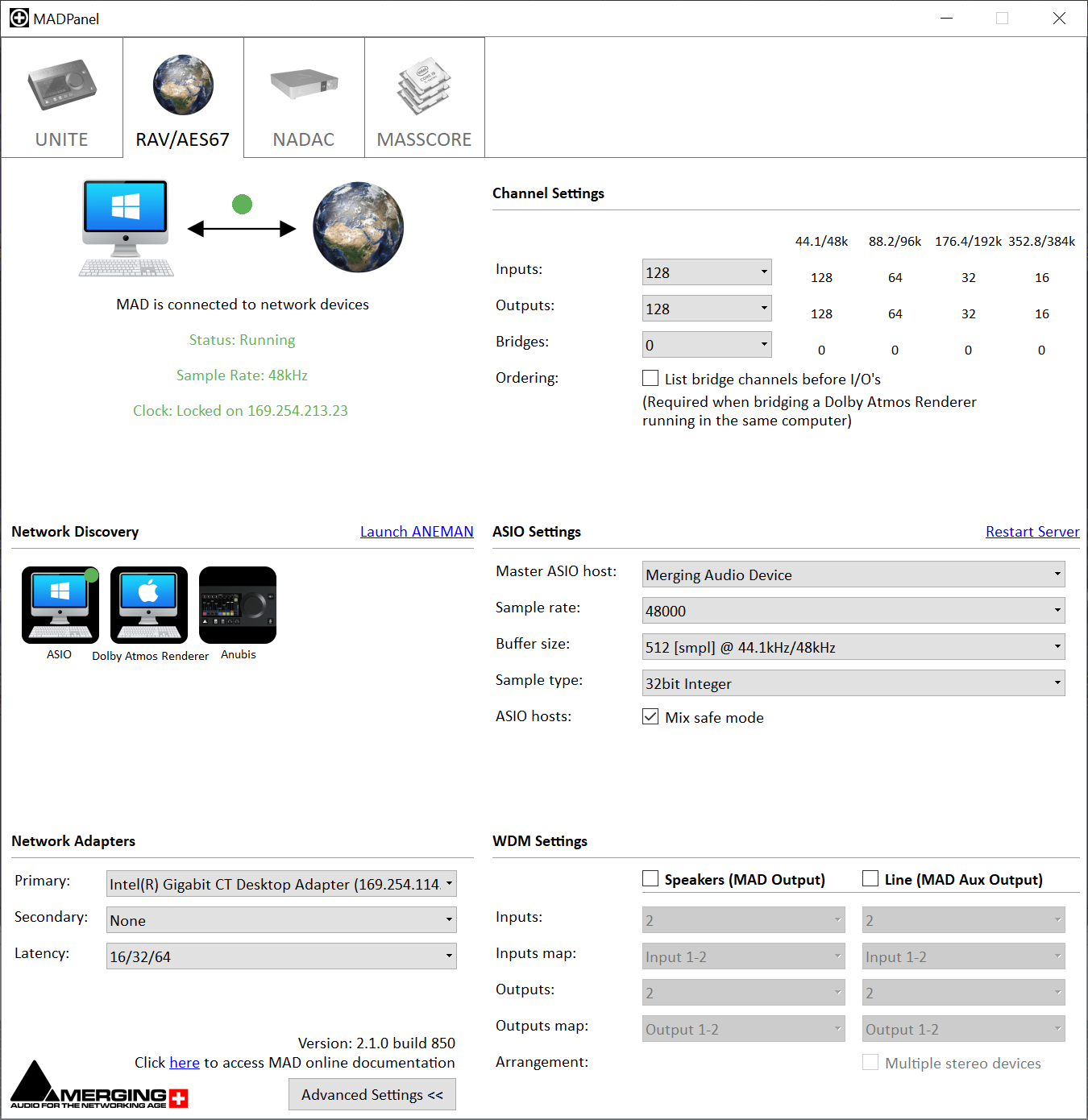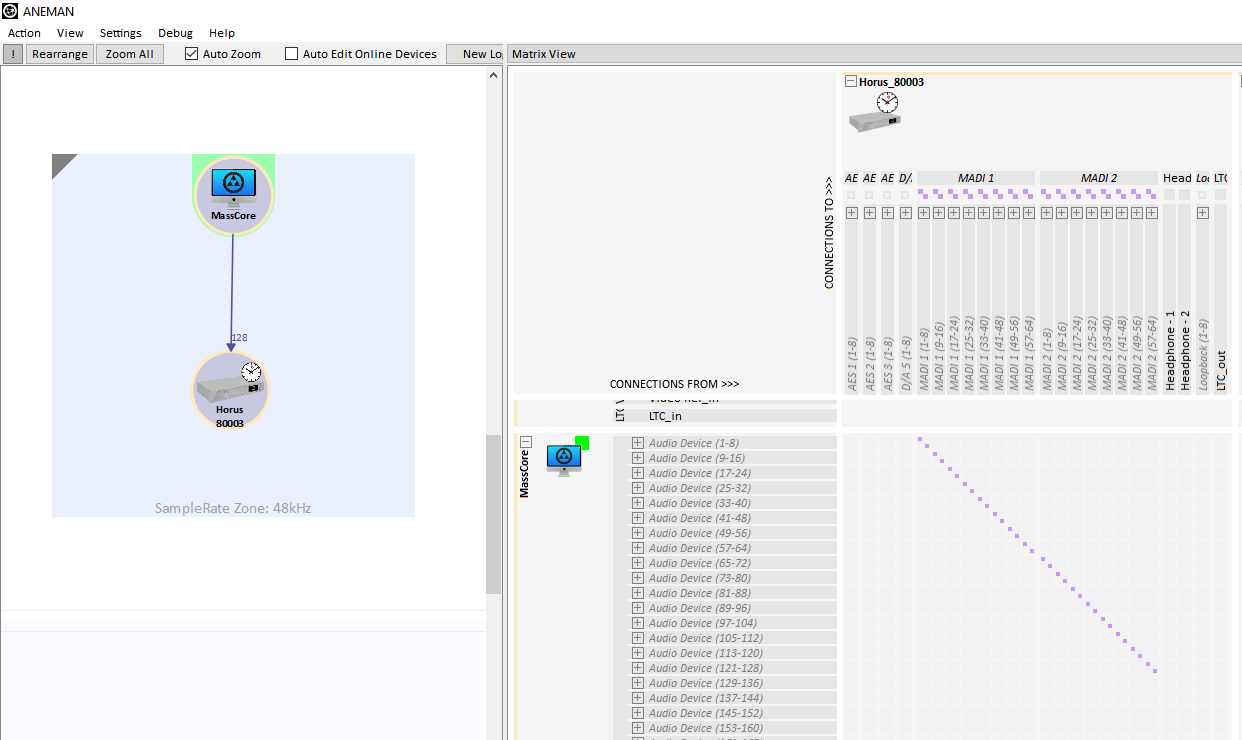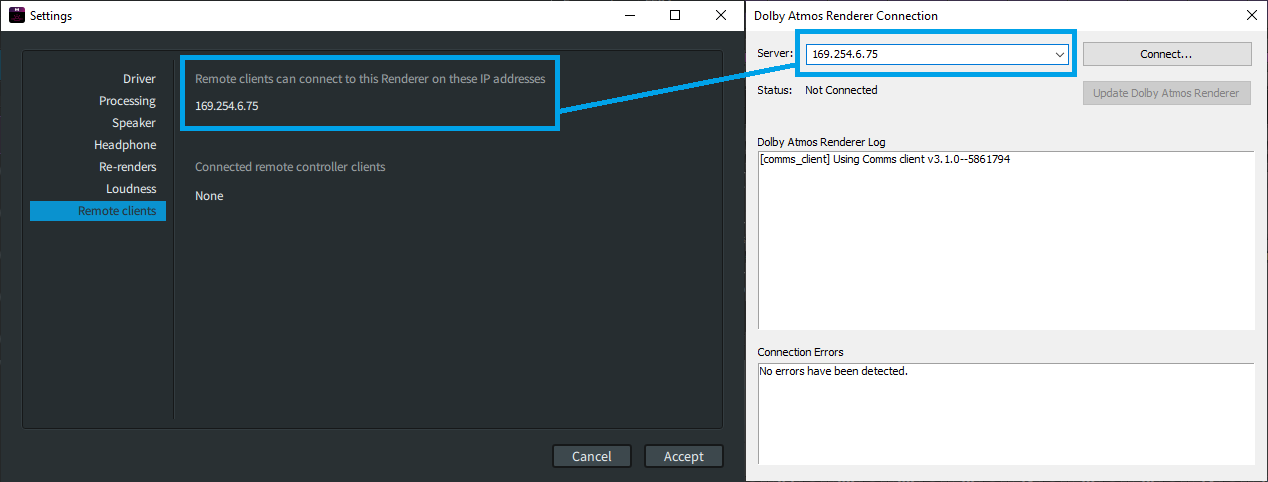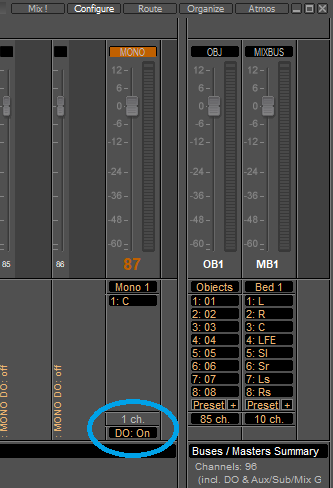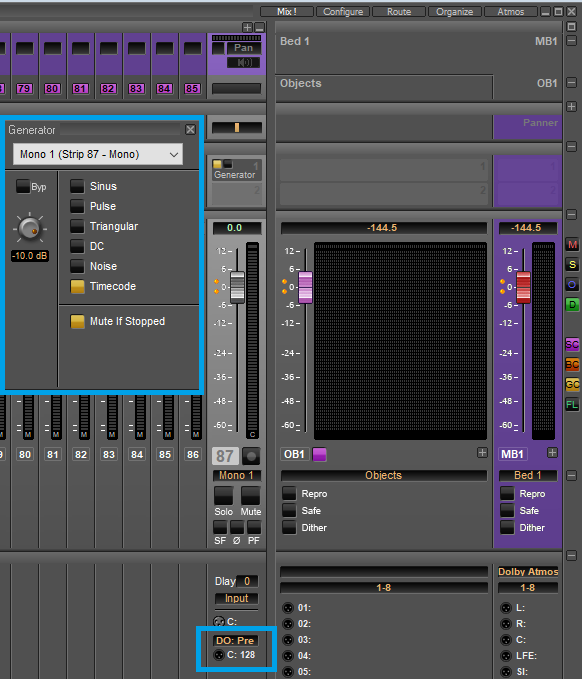Connecting Pyramix MassCore or Native to Dolby Atmos® Renderer MADI HE-RMU.
Prerequisites
- Pyramix 14.0 (or above) must be installed and authorized with Premium key for Dolby Atmos features.
- MADI HE-RMU computer.
For details on the HE-RMU computer, please consult its documentation. - Pyramix Native users : Merging Audio Device V2.1 (or above)
- Merging Horus : up to 128 channels with MADI and MADI extension card.
Merging Hapi or Hapi MKII : up to 64 channels per unit. - If using several Hapi - Hapi MKII, a properly configured managed network switch. See this page for details and configuration guides.
- Network connection between the Pyramix computer and the HE-RMU.
Scope
In this configuration, up to 128 channels can be sent from Pyramix MassCore or Pyramix Native in the MADI HE-RMU.
- Timecode is required for real-time Loudness measurement in the Dolby Atmos Renderer, and will use 1 audio channel.
- The Dolby Atmos authoring process can be quite CPU intensive, depending on the size of your project.
Therefore, Merging recommends running Pyramix on i7 CPU (or more) with 16 Gb of RAM (or more). - Recording back Live Re-renders on the Pyramix computer is possible. The number of channels may vary depending on your computer and project configuration.
Exporting Re-renders offline from the Dolby Atmos Renderer application is possible when opening the Dolby Atmos ADM Master file (Export Audio > Re-Renders). - Currently Pyramix can only export 48kHz Dolby Atmos ADM Master files.
Configure the Pyramix drivers
- Pyramix MassCore
Open the VS3 Control panel, and set the Latency to Low Latency (RAVENNA).
Core assignation : The Dolby Atmos authoring process can be quite CPU intensive, depending on the size of your project, for both MassCore assigned Cores, and also for the Windows ones.
Multicore MassCore (SMP) preferred solution.
Merging recommends you assign at least as much cores to Windows as to MassCore. - Pyramix Native - Merging Audio Device
Please open the MAD Panel, and click on Advanced settings :
Set MAD in RAV/AES67 mode
Set Merging Audio Device as Master ASIO Host
Set the sampling rate to 48000
Set the Buffer size to 512
Set the required Number of Inputs and outputs:
Up to 128 Inputs and outputs (requires 2 MADI modules), but unused channels will still use some power processing.
Therefore Merging recommends you rather set the number of channels you need ; e.g. if you don't plan to use Live Re-renders, 8 inputs are sufficient.
Merging recommends you disable the MAD - WDM, or do not set the WDM outputs to any Bridge channels, to avoid having the WDM channels routed into the Dolby Atmos Renderer.
Set the Latency to 16/32/64 (RAVENNA).
Click on Apply - Horus - Hapi - Hapi MKII
Browse to Setup > System, and set the Latency to Low 64 smp (RAVENNA).
Configure LTC in the Dolby Atmos Renderer application.
Start the Dolby Atmos Renderer.
- Go in Preferences (Mac) or File > Settings (Windows)
- Set the External sync source to LTC over Audio
Set the LTC input channel to 128 (or adapt to the number of inputs you have set in the driver, or if you don't have 128 MADI channels).
Set the required Frame rate
Connect the audio inputs and outputs with Aneman
Please start Aneman.
- Create a Sample Rate Zone (if you don't already have one)
Drag and drop Pyramix MassCore or Pyramix Native ASIO on the top of the zone (inside the crown icon).
Drag and drop Hapi - Hapi MKII - Horus inside the zone.
Connecting Pyramix to the Dolby Atmos Renderer
- In the World view (left pane)
Native users: select ASIO and the Hapi, Hapi MKII or Horus.
MassCore users: select MassCore and the Hapi, Hapi MKII or Horus. - In the Matrix (right pane), connect the relevant Pyramix outputs to the Hapi, Hapi MKII or Horus MADI outputs.
Note : the number channels to connect should be set in accordance with the driver and the Dolby Atmos Renderer configuration.
E.g. If you have set the LTC Input to channel 128 in the Dolby Atmos Renderer, obviously you have to connect the corresponding Pyramix output 128.
This screenshot show the connection with a Pyramix MassCore to a Horus equipped with 2 MADI Modules. - If you plan to use Live Re-renders, please also connect the relevant MADI on Pyramix inputs.
The Live Re-enders channels number is set in the Dolby Atmos Renderer - Windows - Room Setup - Routing Tab.
Pyramix DAW Configuration
- Please start Pyramix.
- Create a Dolby Atmos compatible project, or Open an existing one, or Import a Dolby Atmos ADM Master.
Open the Pyramix mixer, and click on the Dolby Atmos button on the top right corner.
Select the detected Dolby Atmos Server, Pyramix is now connected to the Dolby Atmos Renderer - the Mixer Dolby Atmos button will turn green.
Note : If the Dolby Atmos Server is not automatically detected, enter the Advanced menu. You may then enter the Dolby Atmos Server IP adress in the Server field.
This IP address can be found in the Dolby Atmos Renderer Settings (Windows) / Preferences (Mac) > Remote clients.
If it still do not work, please make sure the network connection between the Pyramix computer and the HE-RMU is working.Timecode
- As the LTC audio channel will use 1 channel, do not exceed 127 bus outputs (Beds + Objects)
- Go in the Mixer Configure page, add a Mono strip, and activate its DirectOut (DO)
- Back in the Main mixer page, add the VS3 Effect > Generator on the strip.
Open the Generator plugin, and set it to TimeCode, ) and set the output level (-10 should be adequate) (set Mute if Stopped according to your needs) - Set the Strip Direct Out to 128.
You may also set the Direct Out to Pre (Pre fader) - Alternatively, you can create an additional Stereo bus to route the LTC, and set it to Routing Safe in the Project > Edit Dolby Atmos Master Configuration page.
- Now, to connect the audio and the Dolby Atmos Configuration from Pyramix to the Dolby Atmos Renderer, please go in Project > Edit Dolby Atmos Master Configuration.
Configure the Dolby Atmos channels as required, then click on Update Dolby Atmos Renderer.
Pyramix will send the Dolby Atmos configuration to the Dolby Atmos Renderer, and also automatically route the Mixer bus channels accordingly.
Close the window once finished (for more details on the Dolby Atmos Master import, export and configuration, please see Pyramix User Manual). - Note on the Automatic Routing
When using the Update Dolby Atmos Renderer, all the bus channels that doesn't have an Atmos mapping will have their routing removed; the additional busses won't be routed anymore.
You may prevent the automatic routing to modify additional busses outputs by activating the Routing Safe option in the Edit Dolby Atmos Master Configuration page.
Notes
- Dolby® Dolby Atmos, and the double-D symbol are registered trademarks of Dolby Laboratories
Licensing Corporation. Confidential unpublished works. Copyright 2021 Dolby Laboratories. All
rights reserved. - Apple Mac M1 users : as of today (Dolby Atmos Renderer v3.7.3), the Dolby Atmos Renderer is compatible with, but not fully qualified on, M1 Macs, as the Renderer runs as an Intel process (see Activity Monitor under the “Kind” column) via the Rosetta 2 translation layer, which may cause performance issues.
